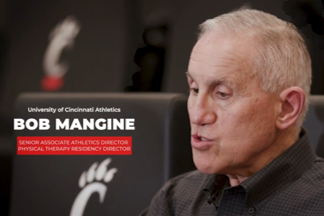NEWS
CLR Advantage™ in the media

NEW SPORTS MEDICINE TECHNOLOGY: HOW YOUR BRAIN AFFECTS YOUR BODY’S MOTION WITH DR. MICHAEL MARK
PODCAST | RICHARD OELBERGER
Dr. Michael Mark is a neurophysiologist with 30 years of experience designing, developing and implementing biofeedback training programs for some of the world’s largest sports teams. Working alongside his team, he pioneered the integration of advanced SaaS solutions with real-time analytics to revolutionize athlete assessment and training, positioning the organization at the forefront of sports neurorehabilitation technology.
Dr. Mark's work not only reflects a passion for sports performance but also a dedication to enhancing neurophysiological capabilities and recovery outcomes. As Chief Science Officer he and his team are working to revolutionize human performance training with the patent pending CLR Advantage™ neurophysiological assessment and training platform.
Prior to CLR, Dr. Mark served as founder and CEO of sports neurofeedback consulting firm, NeuroEdge and Elite Sports Performance. Throughout his career, he has worked with athletes and teams in the MLB, MLS, NBA, NFL, NHL, MMA, BJJ, Collegiate Baseball, Gymnastics, PGA and the Premier League

TASK-DRIVEN NEUROPHYSIOLOGICAL QEEG BASELINE PERFORMANCE CAPABILITIES IN HEALTHY,
UNINJURED DIVISION-I COLLEGE ATHLETES
International Journal of Sports Physical Therapy / November, 2024
Athletic performance can be measured with a variety of clinical and functional assessment techniques. There is a need to better understand the relationship between the brain’s electrical activity and the body’s physiological performance capabilities in real-time while performing physical tasks related to sport.
Orthopedic functional assessments used to monitor the neuroplastic properties of the central nervous system lack objectivity and/or pertinent functionality specific to sport. The ability to assess brain wave activity with physiological metrics during functional exercises associated with sport has proven to be difficult and impractical in real-time sport settings.
Quantitative electroencephalography or qEEG brain mapping is a unique, real-time comprehensive assessment of brain electrical activity performed in combination with physiometrics which offers insight to neurophysiological brain-to-body function. Brain neuroplasticity has been associated with differences in musculoskeletal performance among athletes, however comparative real-time normal data to benchmark performance capabilities is limited.

ROBERT MANGINE, UNIVERSITY OF CINCINNATI SENIOR ATHLETIC DIRECTOR OF SPORTS MEDICINE,
DISCUSSES THE HISTORY AND INNOVATION AT THE STORIED ATHLETIC TRAINING CENTER
Bob Mangine, PT, ATC joins broadcaster Tony Pike, coach Luke Fickell, associate AD Aaron Himmler and executive Michael Shannon in a brief discussion on how Novacare partners with the University of Cincinnati to provide athletic training services, educational opportunities and innovative rehabilitation practices. For the past 20 years, this unique relationship with rehabilitation leader, Novacare has worked to keep athletes safer and helped them to win numerous championships for the UC Bearcats.

THE LONGITUNDINAL NEUROPHYSIOLOGICAL ADAPTATION OF A DIVISION 1 FEMALE LACROSSE PLAYER
FOLLOWING ANTERIOR CRUCIATE RUPTURE AND REPAIR: A CASE STUDY
International Journal of Sports Physical Therapy / April 1, 2023
Neurophysiological adaptation following anterior cruciate ligament (ACL) rupture and repair (ACLR) is critical in establishing neural pathways during the rehabilitation process. However, there is limited objective measures available to assess neurological and physiological markers of rehabilitation. To investigate the innovative use of quantitative electroencephalography (qEEG) to monitor the longitudinal change in brain and central nervous systems activity while measuring musculoskeletal function during an anterior cruciate ligament repair rehabilitation.
A 19 year-old, right-handed, Division I NCAA female lacrosse midfielder suffered an anterior cruciate ligament rupture, with a tear to the posterior horn of the lateral meniscus of the right knee. Arthroscopic reconstruction utilizing a hamstring autograft and a 5% lateral meniscectomy was performed. An evidence-based ACLR rehabilitation protocol was implemented while using qEEG.